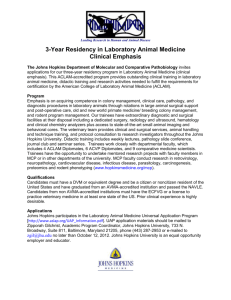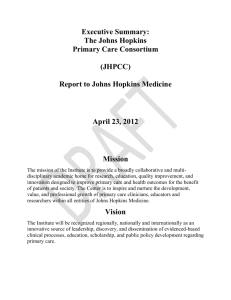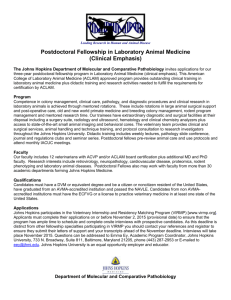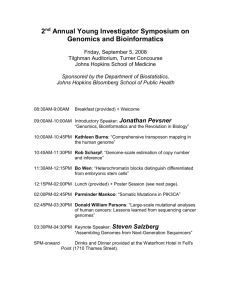STRAUB CLINIC & HOSPITAL
advertisement
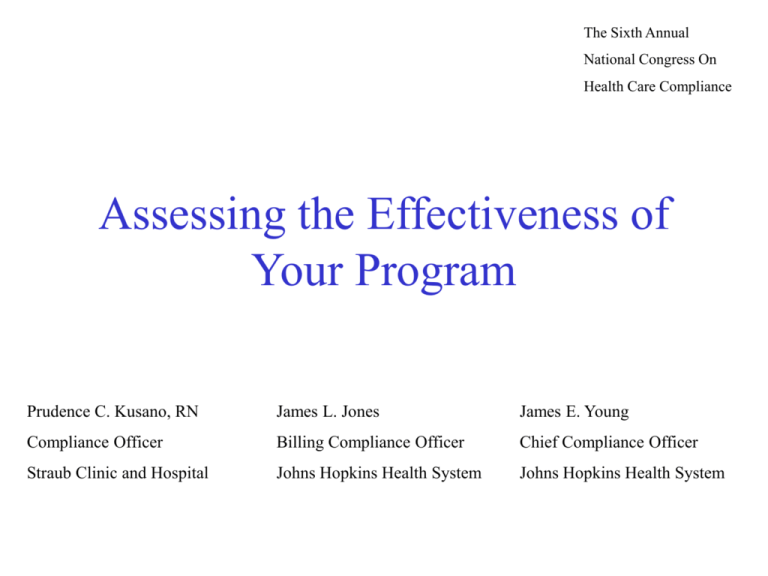
The Sixth Annual National Congress On Health Care Compliance Assessing the Effectiveness of Your Program Prudence C. Kusano, RN James L. Jones James E. Young Compliance Officer Billing Compliance Officer Chief Compliance Officer Straub Clinic and Hospital Johns Hopkins Health System Johns Hopkins Health System Compliance Officer or CORF Operator ????? Appeared in the February 2003 Issue of Money magazine Presentation Objectives • Brief Background on Our Respective Institutions • Defining Effectiveness • Assessing Effectiveness • Questions and Answers ABOVE ALL ELSE → Keep it Interactive!!! STRAUB CLINIC & HOSPITAL Demographics • Affiliate of Hawaii Pacific Health • 159 Bed Acute Care Hospital – – – – – – 3 Bed Burn Unit 16 Bed Intensive Care Unit 32 Bed Telemetry Unit 108 Medical-Surgical Beds Emergency Department 5 Operating Rooms STRAUB CLINIC & HOSPITAL More Demographics • • • • • • 160 Employed Physicians 9 Satellite Clinics Main Specialty Clinic % Medicare: 44% Annual Clinic Visits: 630,200 Annual Admissions: 6,000 STRAUB CLINIC & HOSPITAL Compliance Resources • Compliance Officer-1.0 FTE • Coding Auditing Staff – 5 FTE for Professional Coding – 2 FTE for DRG Coding • Coding Staff – 10 FTE Physician Liaisons STRAUB CLINIC & HOSPITAL Compliance Program • Implemented January 1996 Using the OIG Model Compliance Plan for Hospitals • Settlement of $2.4M with 5-Year CIA, August 1998 • CIA Revised in 2000 • Compliance Program Assessed Annually Johns Hopkins Health System Demographics • Three Acute Care Hospitals – Two Academic and One Community • Just Under 1,500 Licensed Beds • Providing Over 20 Clinical Specialties • More than 3,300 Affiliated Physicians • Over 14,700 Employees • Home Care, DME, Primary Care Sites, Risk-Based Contracting Orgs, TPA, etc. Johns Hopkins Health System More Demographics • • • • • 890,200 Outpatient Visits Annually 73,900 Annual Discharges 25% of Gross Revenue from Medicare 18% of Gross Revenue from Medicaid Maryland is an All-Payer State and Holds a Waiver Exempting Maryland Hospitals from PPS Reimbursement Johns Hopkins Health System Compliance Resources • Compliance Officer – 1.0 FTE • Billing Compliance Officer – 1.0 FTE • Coding and Reimbursement Specialist – 1.0 FTE • Compliance Auditors RN – 3.0 FTEs • Compliance Auditor – 1.0 FTE Johns Hopkins Health System Compliance Program • • • • Began Implementing End of 1998 Still Implementing Program Completely Voluntary Coordinate with Johns Hopkins University Compliance Program Defined A compliance program is a formalized set of business practices that are designed to prevent, detect and respond to business conduct that is inconsistent with Federal, State and local laws and/or company values. Defining Effective Webster’s defines “effective” as producing a decided, decisive, or desired result. U.S. Sentencing Guidelines defines an “effective [compliance] program” as a “program that has been reasonably designed, implemented, and enforced so that it generally will be effective in preventing and detecting criminal conduct” (§8A1.2(k)). OIG Elements Necessary for Effective Program • Written Policies and • Enforcement of Procedures Standards • Formal Structure and • Auditing and Appropriate Oversight Monitoring • Training and • Appropriate Response Education to Allegations • Lines of Communication Written Policies and Procedures Activity Measure of Effectiveness In Collaboration with Subject Matter Stakeholders, Draft Various Compliance-Related Policies & Procedures (e.g. Standards of Conduct) for Appropriate Approval and Implementation DOCUMENTATION – Written Policies & Procedures with Executive Management Approval and Sponsorship Communicate Policies & Procedures to all Employees within the Organization Who have a Need to Know DOCUMENTATION – Post Policies & Procedures on Organizational Web Site; Where Appropriate, Mass Mail Policies to all Affected Employees Affirm Employee Understanding of DOCUMENTATION – Hold Policies & Procedures Training Sessions, Document Attendance and Content, Employees Sign Documents Indicating Receipt and Agreement to Abide Formal Structure & Oversight Activity Measure of Effectiveness Highest Level of MGT Responsible for Compliance Program Oversight (Board, Board Committee, CEO) DOCUMENTATION – Plan Document, Regular Summary Reports in Minutes Compliance Officer has Appropriate Authority and Experience DOCMENTATION – Plan Document, Resume, Documentation of Disciplinary Activities, Correspondence with Management The Compliance Function is Adequately Funded Benchmarking – HCCA Annual Survey of Health Care Compliance Officers Active and Broadly Constituted Compliance Committee DOCUMENTATION – Plan Document, Membership Roster & Participation, Meeting Minutes Training & Education Activity Measure of Effectiveness Develop and Implement an Annual Compliance Training Plan DOCUMENTATION – Publish Reports to Management Showing Actual Versus Planned Training for a Given Time Period Tailor Training Methods to Meet the Needs of the Department and its Employees. DOCUMENTATION – Compare Participation % (# Actually Trained/ # that should have been Trained) of Various Training Methods; Survey Employees Collaborate with Departmental Management in Designing the Training Content and Materials DOCUMENTATION – Maintain Training Materials, Attendance Sign-In Sheets, Employee Evaluation Forms, etc.; Make Compliance Training a Part of Employee Annual Evaluation Objectively Assess Employee Understanding of Subject Matter DOCUMENTATION – Administer and Grade Written Quizzes or Tests; Ideally Give Pre-Training and Post-Training Tests and Compare Results, Pre & Post-Training Audit Results Trend Lines of Communication Activity Measure of Effectiveness Various Reporting Mechanisms DOCUMENTATION – Publicity Materials, Offered to Employees (hotline, e- Training Programs, mail, drop box, fax, face-to-face, etc) Employee Awareness of Reporting Mechanisms DOCUMENTATION – Publicity Program, Training Programs, Employee Surveys, Call Volume after Publicity Use of Reporting Mechanisms DOCUMENTATION – Report Log Recording all Reports from all Mechanisms, Non-Retaliation and Anonymity Policy, Policy Requiring Reporting of Incidents, Annual Performance Evaluation Requests for Information, Compliance Clarification, etc. DOCUMENTATION – Log of Questions and Answers Enforcement of Standards Activity Measure of Effectiveness Existence of Disciplinary Policy and Guidelines DOCUMENTATION – Code of Conduct, HR Policies and Procedures Employee Awareness DOCUMENTATION - Training Programs (Mgrs & EEs), Employee Surveys Enforcement DOCUMENTATION – Disciplinary Reports / Disciplinary Log, Minutes of Disciplinary Committees, Correspondence with External Authorities, Annual Performance Evaluations Background Checks OIG/GSA Screening DOCUMENTATION – Proof of Checks for New Employees/Contractors, Proof of Checks for Active EEs, Disposition of Identified Exclusions, Policy Requiring Disclosure by EEs Auditing & Monitoring Activity Identify Departments or Processes within the Organization that Represent the Greatest Potential Compliance Risk Measure of Effectiveness DOCUMENTATION – Perform a Benchmarking Analysis of Major Functions (e.g. Patient Registration and Billing) to Determine Potential Weaknesses in Internal Controls Develop and Implement an DOCUMENTATION - Publish Reports Annual Compliance Audit Plan Showing Actual Versus Planned Audits for a Given Time Period Conduct Audits as Planned DOCUMENTATION – Document the Audit Program, Maintain Audit Work Papers, Issue Written Audit Reports, Establish Error Rates, Correspondence Returning Overpayments Conduct Follow-Up Audits Where Appropriate DOCUMENTATION - Confirming Corrective Actions Taken and that it had the Desired Results, Trend Analysis Appropriate Response to Allegations Activity Measure of Effectiveness Mechanism to Respond to all Identified Problems DOCUMENTATION – Formal Policy Requiring Investigation, Corrective Action and Reporting Compliance with Policy DOCUMENTATION – Report Log with Resolution, Report with Corrective Actions, Minutes of Board and Compliance Oversight Committee, Correspondence with Payers or Government Agencies Follow-Up Reviews DOCUMENTATION – Written Reports, Trend Analysis, Evaluation of Corrective Actions “Effective” Ideal Ideally an effective compliance program is a program that transcends policies and procedures and is part of the routine fabric of operations.



